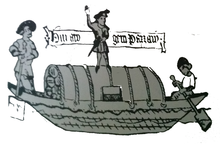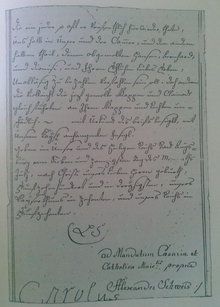Standl
Standl is a family name from Salzburg and is associated with shipping and salt transport on the Salzach .
Origin and history of the sex of the Standl
The name Standl was first mentioned in a document in 1343 (July 4th). In this document, Prince Archbishop Heinrich (1338–1343) renewed the “common and male inherited wealth of the ship owners to run ”. The name Standl appears here as a hereditary advocate and representative of the shipping community. The Standl family was therefore one of the ancestral boatmen families as early as the first half of the 14th century. Only members of these families held the Ausfergenamt and had the right to operate shipping on the Salzach.

The office of Erbaufergen and Erbnaufergen
The export of Hallein salt to water has always been allowed only with archiological Salzburg ships. The citizens of the city of Laufen made use of this right, and as early as the 10th century a distinction was made between two types of citizens who dealt with the export of salt, namely ship owners and Ausfergen; some owned the ships, others led them downstream. Ferg was the leader of a ship or a raft or a ferry in ancient times. In Salzburg a distinction was made between the Ausfergen, which brought the Hallein salt from Hallein to Laufen on the Salzach, and the Naufergen, which shipped the salt from Laufen further downstream to Passau into the puddle. The Ausfergenamt goes back to a loan from Archbishop Wlodizlaus (1265–1270). In 1267 he enfeoffed 27 Laufner ship owners with the "Ouzverigamt". In 1278 Archbishop Friedrich II von Walchen (1270–1284) issued an order for the Ausfergen in Laufen. The Ausfergen belonged to the Laufen patriciate and thus had roughly the same position as the knightly nobility. The Ausfergen expanded their position of power over the next few decades. Their business methods became so rigorous that in 1530 Cardinal Mathäus Lang (1519–1540) intervened and reorganized the office. Up until then, 30 families had made 40 Ausfergen, after that there were only four families, including the Standl family. The family rose to the Salzburg nobility. In 1530, Emperor Charles V expressly recognized the office of Standl with a handwritten letter and gave the family a family coat of arms. The handwritten certificate is still in the family's possession. The Ausfergenrecht states that only the ships of these Ausfergen were allowed to be used for the salt export and that only they were authorized to ship the salt on the ships. They had the sole right to occupy ships and guide them on the river. In the event of war, the Laufner had to provide six "well-armed Ausfergen". The Laufen-Oberndorf ship's rifle corps that still exists today probably has its roots there. The office became a noble fief in the 15th century. Ausfergen had the right to order "others for the real export of the salt" (= ship servants). The four hereditary heirs formed a special class within the Salzburg landed aristocracy, which ranked behind the holders of the hereditary offices, but preceded the other knight families. Every year on the eve of Epiphany, the four hereditary sires had to hand over 32 ducats in a "red velvet bag" to the sovereign. In 1611, following a new treaty, the dominant position of Hallein salt ended, which led to a significant decline in salt shipping with corresponding consequences for Laufen. The new contracts also put an end to the independent entrepreneurship of the pavers, but not of the building sods. The title Erbausferge existed until the beginning of the 19th century. With the secularization all privileges of the Erbauergen expired. The most famous Erbnaufergen families were the Standl and Edelmann.
Meaning of the name and coat of arms
The name is derived from standing. By this one understood the structure in the middle of the Nauffahrt, on which the boatmen could stand. The Nauffahrt was the great barge of the Ausfergen. She was the largest ship in a Meistersalz (= salt ship "convoy", consisting of 31 ships). On it the Ausferge drove ahead of the other Hallaschen. A Nauffahrt was manned by 11 men. Measurements of a drive up: 10 work shoes wide (= 3 m), 19 fathoms length (= 36.8 m).
The coat of arms of the Standl shows the Ausfergen on the stand of a Nauffahrt. The Erbausfergen had the right to mark their ships with their coats of arms. It was a family coat of arms with simple symbol representations that should establish a relationship with the name of the person concerned.
distribution
The family name Standl occurs mainly in the northern Salzburg Flachgau region and in the neighboring Bavarian Rupertiwinkel . Here mainly in the towns of Oberndorf and Laufen . The name Standl is the 6.372. most common name in Austria. The Standls live in 17 cities and communities. Most of them are registered in the Salzburg area, namely 23. Other communities with a particularly large number of namesake are Kufstein (11), Braunau (8), Salzburg (5), and Mödling (4). In Germany there are 78 entries for the name Standl and thus approx. 208 people with this name. They live in 20 cities and counties. Most people with this name are registered in Berchtesgadener Land, namely 26. Other districts / cities with a particularly large number of namesake are Munich (10), Weilheim-Schongau (7), Hagen (5), Rosenheim (5), Mühldorf a. Inn (4) and Erding (4).
Standl is the family name of the following people
- Eberhard Standl (* 1942), German diabetologist
- Günter Standl (* 1963), German photographer and artist
- Harald Standl (1959–2015), German geographer
- Hermann Standl (* 1964), German painter
- Ivan Standl (1832-1897), photographer
- Josef Standl (1954–1970), captain of the Schifferschützen-Corps; 1970–1974 honorary captain and mayor of the Flachgau riflemen
- Josef Alois Standl (* 1945), Austrian journalist and book author
- Rupert Standl (1803–1881), theater director
- Simone Standl , German journalist
swell
- Franz Anthaller: Parish S. Nicola.
- Franz Martin: Small regional history of Salzburg. Salzburg 1949.
- Ralph Robert: Early New High German Dictionary. Volume 2. Berlin 1994.
- Karl Zinnburg: Salt boatmen and boatmen from Laufen-Oberndorf. Salzburg 1977.
- Walter Brugger , Hans Roth: running and Oberndorf. Art and history. Tittmoning 1970.
- Peter Gries: Collegiate Church Laufen / Salzach. (= Great Architectural Monuments , Issue 221). Munich / Berlin 1968.
- Heinz Dopsch and Hans Roth (eds.): Laufen and Oberndorf: 1250 years of history, economy and culture on both banks of the Salzach. Laufen / Oberndorf 1998, ISBN 3-00-003359-9 .




